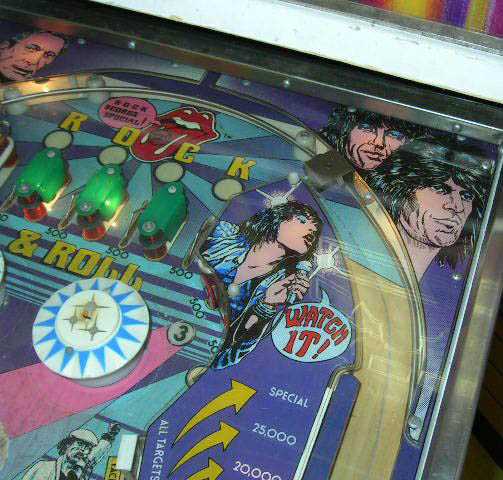The other day we set out to determine Rock Town Hall’s Top 5 Rock ‘n Roll Artists of the ’50s. Although we were not sure how our suggestions would be arbitrated, our faith in the process of discussion and dissent probably implied our reaching concensus. It was not that easy.


Oldsters on this list already know the principle behind this ongoing series here at RTH: long story short — I head out to a local thrift store, spend a dollar or two on music I know nothing about, take it home and give it a spin. If it’s good, I share it.
This one is different. The other day, a stack of classic rock 45s turned up at my local Goodwill. Most of it was boring, heard-it-all-before stuff, but buried in the middle of the pile were three Rolling Stones singles I’d never seen before — and they each featured non-album B-sides. Hearing three Stones tracks that were unknown to me seemed worth the 75-cent investment, so I scooped ’em up.
Now, normally, here’s where I opine about how great my finds were. I’m not going to do that this time. Instead, I’m going to summon our resident Stones-o-phile 2000 Man to weigh in on what I found. I really want to know where he sees these numbers landing on the scale of Glimmer Twins Greatness. Of course, I’m interested in everybody else’s thoughts, too — and I further ask each of you the following probing question: What’s your all-time favorite non-LP B-side — from any band?
I look forward to your responses, and I hope these presumably unknown Stones “trackssss” are enlightening.
HVB
“Everything’s Turning to Gold”, B-side to “Shattered”
“Think I’m Going Mad”, B-side to “She Was Hot”
“Through the Lonely Nights”, B-side to “It’s Ony Rock and Roll”
In a positive sense, what is the correlate of soul?
Let’s be frank, as we look into this question: the term soul is strongly associated with qualities found in African American music. It’s considered a positive quality and a quality that is bound to impress when attained by rock ‘n roll musicians. However, it’s not the be all and end all of rock ‘n roll. Rock ‘n roll can have soul, but we’ve seen it also succeeds through the expression of other qualities, some of which we characterize as “white” musical qualities.
As painful as it may be to process these ideas, you do understand what I’m saying, right? For instance, The Beach Boys are considered a very “white” group – and a great one at that. They took a vocal group tradition that was based partially on what would be considered some of the building blocks of what would lead to soul and made it their own. They came up with a great approach to music, but if it doesn’t have soul, in the sense that we commonly use that term, what does it have? What is the correlating, positive term that can be used to describe musical attributes we typically ascribe to white people?
Continue reading »
Like my 11-year-old son, some of you are probably too young to have any even remotely direct experience with rock ‘n roll from the 1950s, but that doesn’t mean you can’t shed some light on this topic. Over the weekend we were playing an 18-song Buddy Holly Greatest Hits album in the car. My boys have liked this CD the couple of times they’ve heard it in the past, and it’s good summertime music, not to mention simply great music (perhaps by whatever standards we might define great).
Our oldest boy was amazed at how many of Holly’s songs he knew from movies, commercials, and the like. “I can’t believe how many great songs he made,” he kept saying, “almost every song was a huge hit!”
He wanted to know more about Holly, eventually arriving at this core question: “I don’t get it, why is Elvis more famous than him? I don’t see what’s so great about Elvis.”
It was a tough question to handle on the spot like that. Elvis is King, right? I love Elvis, but not including the pathos of Fat Elvis, which was too much to explain to an 11 year old, Buddy Holly may have produced a stronger run of songs during the ’50s. “Elvis’ early singles are really exciting,” I told him, “plus he was more handsome and drove the kids wild.”
I handed him the Holly CD and had him look at the photos of Buddy and the Crickets. “Whoa,” he chuckled, “now I see where Elvis Costello got his Look!” (My wife quickly added, “You know, he was kind of handsome!”)
This all got me thinking, Who are Rock Town Hall’s Top 5 Rock ‘n Roll Artists from the ’50s? I ask us to discipline ourselves and refrain from throwing acknowledged blues artists (eg, Muddy Waters) and other ‘tweeners (eg, Louis Prima – I’m looking your way, HVB!) into the mix. Rock ‘n roll. This could include, as the genre is usually defined, vocal groups, such as The Platters. But no Muddy Waters, no Hank Williams, no Louis Prima, no jazz. Got it?
We’re announcing the Most Rockin’ Breakfast Cereal award winner for the month of July a little earlier in the month than usual. I’m sure we all feel confident that Townsman Hrrundivbakshi is the clear-cut winner for his Top 5 Rock ‘n Roll Artists of the ’50s Rating Scale. Congratulations!

